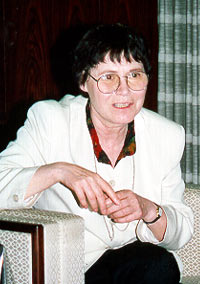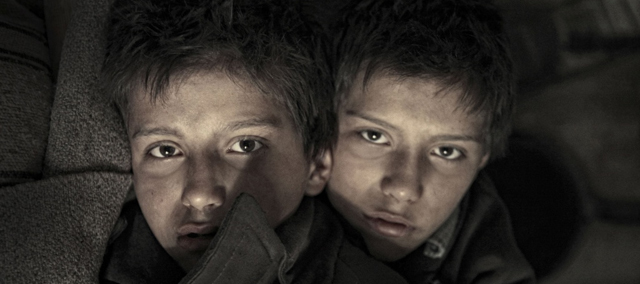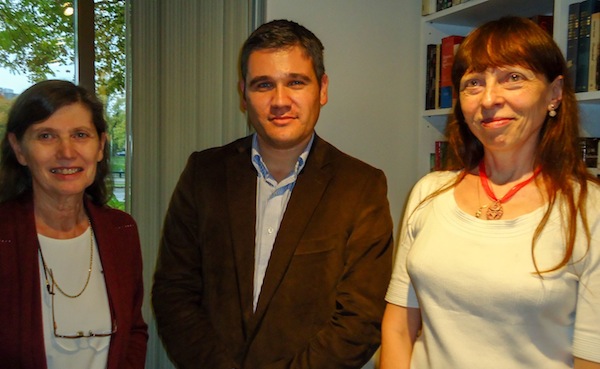November 10th 2014
By Kevin Burns
When a feature film based on a novel by a Hungarian-born author who fled that country in 1956 was scheduled at the local cinema, the CHEF website decided to take a closer look.

Source: UNHCR
The 2013 film, A nagy füzet, is an adaptation of the novel Le grand Cahier written in French by Agota Kristof and published in 1986 in her adopted country since 1956: Switzerland. The novel follows the experiences of twin boys who are packed off to the presumed safety of their grandmother’s farm outside a village as war rages all around. Far from being protected, the young boys are surrounded by violence and they witness first-hand how in order to survive terrible choices are involved. The film removes much of the intentional ambiguity of the original novel and sets the action clearly in Hungary during the Second World War.
Directed by János Szász, the film was Hungary’s entry in last year’s Academy Awards. It is an adaptation of the first novel in a trilogy by Agota Kristof who was born in Hungary in 1935. She fled to Switzerland in 1956 and lived there until her death in 2011. She wrote in French, not Hungarian. After “The Notebook” came “Proof” in 1988, and then in 1991, “The Third Lie.” Kristof did not live to see this film version of her first novel, she died in 2011.
The Notebook − not to be confused with Nick Cassavetes’ 2004 romantic film with the same title − is now doing the rounds of Canadian repertory cinemas. This novel and film are the work of an immigrant writer who left one country for another, and who chose to write about it by addressing events from the past, exploring them in a new language. These issues resonate strongly within Canadian-Hungarian circles. The much quoted – though perhaps less-read − British novelist L. P. Hartley opened his 1953 novel, The Go-Between, with the memorable line: “The past is a foreign country: they do things differently there.” Indeed it is. And for many, that past does involve another geographical country.

Given all of these links, CHEF invited three knowledgeable people to talk about the book, the film, and the issues that they raise. After a recent screening of The Notebook, Judy Young-Drache, president of CHEF, Christopher Adams, historian and board member of CHEF, and Agatha Schwartz, a professor in the Department of Modern Languages and Literatures at the University of Ottawa, shared their reactions. Kevin Burns listened in on their conversation and prepared these excerpts:
First Impressions
Christopher Adam
Well right away as an historian and as someone interested in literature, I noticed right away the concept, a trope, in that film and it’s about gender. There’s a grandmother, this evil woman who possibly killed her husband, living on the edge of town, on a farm. This image resonates quite a bit in Western culture. Single women, seen as evil, who are vilified, living in isolation from the town they are close to. In the film you see a character who at first comes across as rough, a villain. She works hard and forces the boys to work hard too in the film. You want food? You work for it. But as the film moves along you see a little bit of humanity begin to seep into her, I think.
Agatha Schwartz
Yes, in the book, which I have read, the grandmother is written more as kind of fairy-tale witch character and in the film she is much more earthy. The film takes away, I think, some those fairy-tale elements of the book. There are other fairy-tale equivalents, marginal characters with evil forces and who can influence the lives of others. The boys actually carry out some evil deeds in the film that the book only suggests. The book leaves empty spaces that the reader has to fill-in while the film fills much of that in for you.
Judy Young-Drache
That’s interesting, what caught my attention was the psychology of the old woman whose daughter brings her sons to her after a gap of not seeing her for twenty years. It’s as if the old woman now decides to pay her back for some earlier unkindness – an event mentioned only obliquely in the film. There’s a difficult family dynamic at work here that hasn’t worked out, for whatever reason. There are lots of mysteries like that at work in this film.

Judy Young-Drache, Christopher Adam, Agatha Schwartz
How does this film portray the effects of war?
Christopher Adam
What I felt watching this film was that it was almost a how-to guide as to how create a sociopath or a child soldier. How do you de-sensitize someone so completely and turn them into someone so very different? If you look at the situation of what war does to children, I think this is very powerfully addressed in the film.
Agatha Schwartz
The new environment the boys find themselves in is shocking. We see how they are turned into sociopaths, yes, and at the same time they still keep a grain of humanity because they are able to distinguish between good and bad. They are not cruel for cruelty’s sake. They build an armour to survive the terrible cruelty of that time. It shows how an average “normal” psyche can survive even in the most extreme of circumstances. The book is an accusation of society and of history. Watching the film brought to mind the experience of trauma: these boys are victim of continuous traumatization.
Judy Young-Drache
I actually don’t see them as sociopaths, as you say. They do distinguish between good and evil and reward, to some degree, the good despite all the things that surround them. I think there are really only two characters in the film who are shown in some kind of positive light: the shoemaker, who happens to be a Jew, and the SS officer, who shows something like affection for them. But a lot of things are ambiguous here. It’s not always clear. I thought of it as something like a mediaeval morality play with people not so much deeply defined as characters but more as archetypes.
Although the book is enigmatic about time and place, the film is clearly set in Hungary during the Second World War. What about this interplay of fiction and history in novels and films?
Christopher Adam
Fiction and history. Where is that dividing line? Some of the most conservative historians are now writing books where they weave in their personal story openly into the work and this would have been anathema twenty years ago…
Agatha Schwartz
Yes, this dividing line between documentary is not there anymore. The act of interpretation is there for whoever writes or tells or reads a story. If you rely on the stories of witnesses, who is telling the truth? Everything is tainted from a personal perspective. This is precisely what Kristof is doing – she is taking some historical moments to show these gaps that history leaves open to interpretation. What she is doing is actually showing us a kind of psycho-gram of what history and violence actually do to the human psyche, and especially to children when their childhood is stolen from them by the violence and cruelty that they witness.
Overall, then, what does this achieve?
Judy Young Drache
I think this is a work of art that is restrained in some way, in the way it holds back on some details, I think it leaves some important questions in the air.
Agatha Schwartz
To me this is a very truthful depiction of twentieth century history, as I said earlier, I see it as a kind of psycho-gram of what that history has done to a young generation that is exposed to abuse and brutalization and how they in turn become brutal.
Christopher Adam
I think there was no gratuitous violence in this film. You see the boys’ dispassionate accounting for what happened in the diary entries in the notebook, but not visually what happened. Once you are exposed to violence, whether it’s in real life or on television, you will become de-sensitised by it and I think this is a reality that is depicted very clearly in this film.
Here are three short audio clips from the conversation:
1: Anything missing from this book and film?
Order of speakers: Christopher, Agatha, Judy. (2: 09)
2: Where history ends and fiction begins – where fiction ends and history begins.
Order of speakers: Christopher, Agatha, Kevin, Agatha, Judy, Agatha, Judy. (2:24)
3: One leaves, one stays. And then what?
Order of speakers: Judy, Christopher, Judy, Agatha (3:44)
The English language version of the trilogy is published by Grove Press and the French language editions is published by Éditions du Seuil. Sony Pictures Classics own the North American rights to this film, meaning that a DVD version of “The Notebook” is highly likely in the months ahead.

Trilogy English Book Cover – Courtesy of Grove Pr
